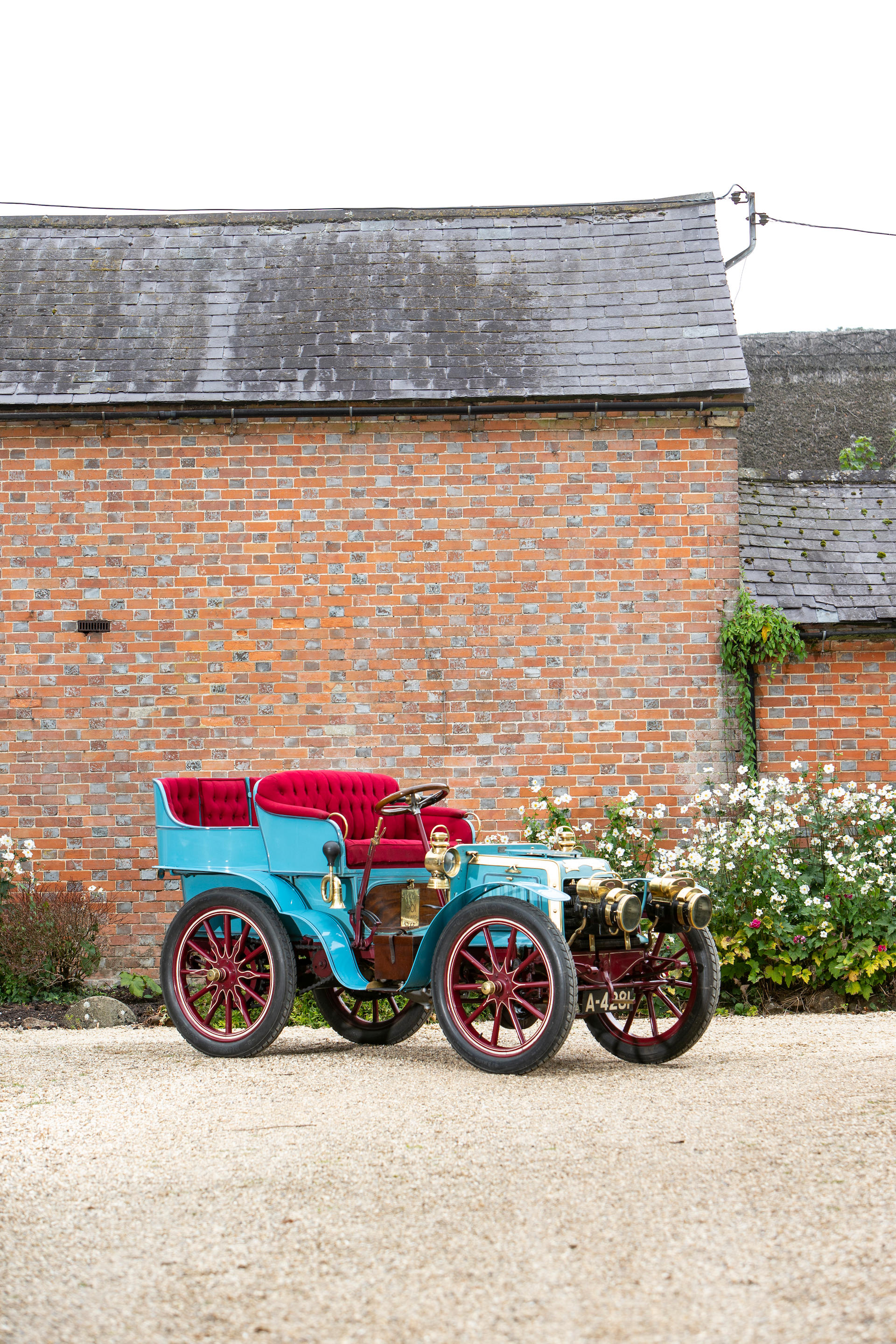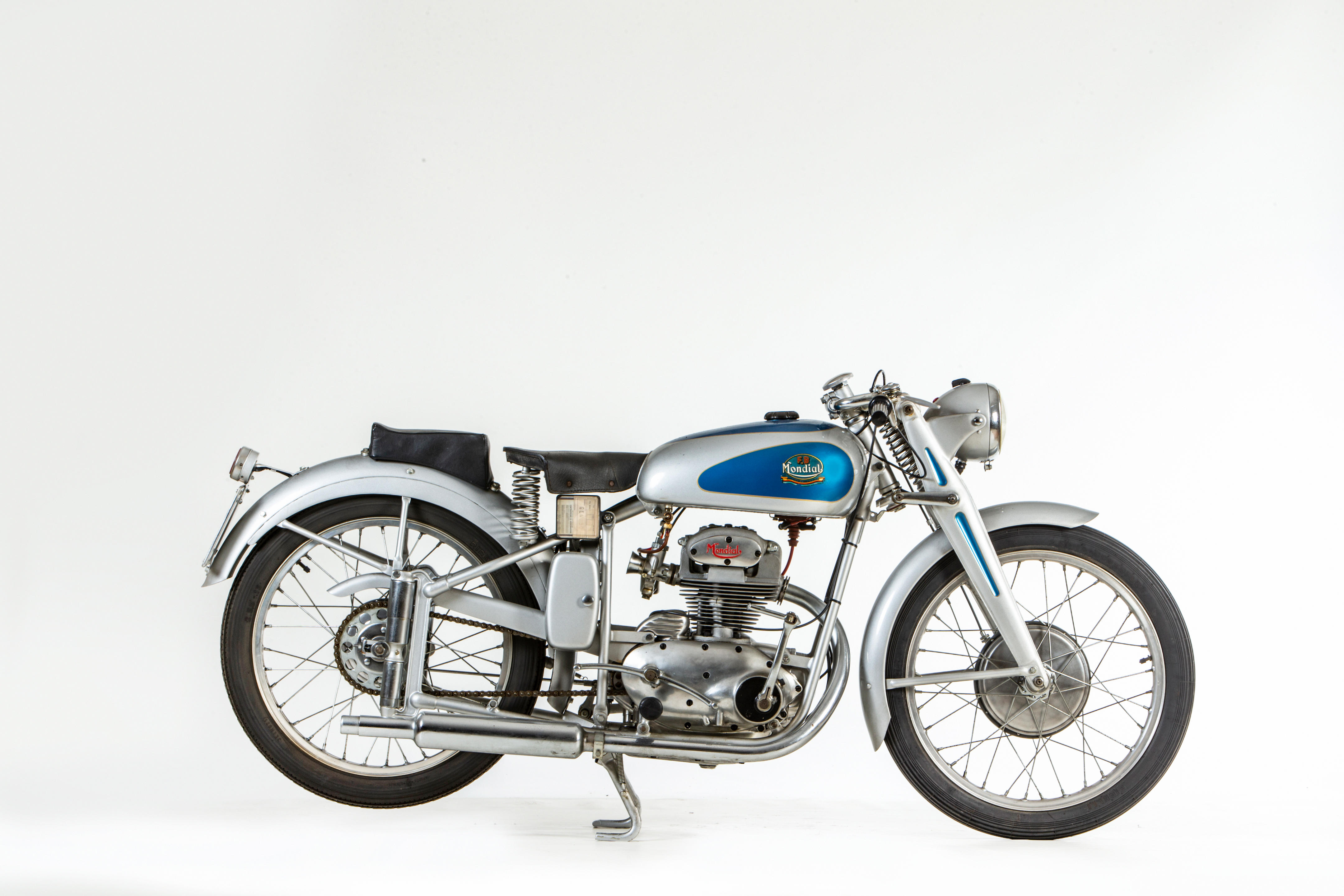Offered with an entry to the 2019 London to Brighton Veteran Car Run 1903 Oldsmobile Model R 'Curved Dash' Runabout Registration no. to be advised Engine no. 16150 *Formally in the Pembroke Motor Museum Collection *Many times London to Brighton Veteran Car Run entrant *Consistant finisher *Optional extra seating *Registered new in the UK Fußnoten Known as the 'Curved Dash' for obvious reasons, Ransom Eli Olds's gasoline-powered runabout was first offered for sale in 1901, following a fire at the factory that had destroyed every other prototype. Over 11,000 of the three Curved Dash models ('R', '6C' and 'B') were constructed before production ceased in 1907, making it the first volume-produced American automobile. The Model 'R' runabout was powered by a single-cylinder, 1.6-litre engine of 114x152mm bore/stroke, mounted horizontally at the rear and producing 5 horsepower at 600rpm. Later '6C' and 'B' models benefited from a more-powerful (7hp) 1.9-litre engine and all featured two-speed epicyclic transmission and chain final drive. Several improvements to the design were made during the course of production, but the engine's basic layout remained unchanged. Two mechanically operated overhead valves were set side-by-side at 90 degrees to the cylinder axis, and the rocker arms had roller ends. An ignition contact-breaker was mounted on the end of the camshaft, and sparks provided by a trembler coil. By 1902, the mixer-type carburettor had been replaced by a float-less design, while a manually adjustable valve in the exhaust system vented exhaust gases via the silencer box or more or less straight to the atmosphere, the two settings presumably being intended for town and country use respectively. Cooling water was contained in a reservoir above the engine and circulated by a crankshaft-driven pump, mounted on the side of the chassis. The radiator's copper piping wound its way back and forth beneath the floor. Despite appearances to the contrary, the suspension's leaf-springs which linked the front and rear axles were not true half-elliptics like those fitted to the later model 'B' cars. On the 'R' and '6C' models, only the bottom leaf ran from front to rear, so it would be more accurate to describe these as four quarter-elliptics. Steering was by means of a tiller, a common enough method in the early 1900s, while there was a choice of brakes: one acting on the transmission, the other on the differential. The wheels were un-braked. This Curved Dash Runabout was purchased new by Mr Edward Williams of Bromyard, Herefordshire in 1903. Mr Williams, who was 38 years of age at that time, had a de-mountable, upholstered platform made and fitted on the rear of the vehicle, which he used as a taxi, with two passengers facing rearwards. The passenger-carrying compartment was entered through a small door similar to a horse trap. Thus the car has the option of being driven with four seats or two. Clearly a man with more than his fair share of entrepreneurial flair, Mr Williams installed an electric generator in the shed in which the Oldsmobile was garaged, and sold the electricity it produced to his neighbours. In 1948 Veteran Car Club member, Geoffrey Smith found the car and the electric generator in the shed, which had by that time collapsed on its contents. Two years later Mr Chester Smith, of Pembroke Motor Museum, persuaded Mr Williams to sell the car and immediately set about restoring it. The restored car was taken back to Mr Williams in 1952 for him to see from his bedroom window - he died very shortly afterwards. From 1954 to 1982 the car was on exhibition at Chester Smith's Pembroke Motor Museum and during this period took part in the London-Brighton Run annually. In 1982 the museum closed down and the Oldsmobile was sold at auction to a dealer when the collection was dispersed. It was purchased from the dealer by David Leach its third private owner, who completed four London-Brighton Runs with the car. The Olds was purchased by it
Offered with an entry to the 2019 London to Brighton Veteran Car Run 1903 Oldsmobile Model R 'Curved Dash' Runabout Registration no. to be advised Engine no. 16150 *Formally in the Pembroke Motor Museum Collection *Many times London to Brighton Veteran Car Run entrant *Consistant finisher *Optional extra seating *Registered new in the UK Fußnoten Known as the 'Curved Dash' for obvious reasons, Ransom Eli Olds's gasoline-powered runabout was first offered for sale in 1901, following a fire at the factory that had destroyed every other prototype. Over 11,000 of the three Curved Dash models ('R', '6C' and 'B') were constructed before production ceased in 1907, making it the first volume-produced American automobile. The Model 'R' runabout was powered by a single-cylinder, 1.6-litre engine of 114x152mm bore/stroke, mounted horizontally at the rear and producing 5 horsepower at 600rpm. Later '6C' and 'B' models benefited from a more-powerful (7hp) 1.9-litre engine and all featured two-speed epicyclic transmission and chain final drive. Several improvements to the design were made during the course of production, but the engine's basic layout remained unchanged. Two mechanically operated overhead valves were set side-by-side at 90 degrees to the cylinder axis, and the rocker arms had roller ends. An ignition contact-breaker was mounted on the end of the camshaft, and sparks provided by a trembler coil. By 1902, the mixer-type carburettor had been replaced by a float-less design, while a manually adjustable valve in the exhaust system vented exhaust gases via the silencer box or more or less straight to the atmosphere, the two settings presumably being intended for town and country use respectively. Cooling water was contained in a reservoir above the engine and circulated by a crankshaft-driven pump, mounted on the side of the chassis. The radiator's copper piping wound its way back and forth beneath the floor. Despite appearances to the contrary, the suspension's leaf-springs which linked the front and rear axles were not true half-elliptics like those fitted to the later model 'B' cars. On the 'R' and '6C' models, only the bottom leaf ran from front to rear, so it would be more accurate to describe these as four quarter-elliptics. Steering was by means of a tiller, a common enough method in the early 1900s, while there was a choice of brakes: one acting on the transmission, the other on the differential. The wheels were un-braked. This Curved Dash Runabout was purchased new by Mr Edward Williams of Bromyard, Herefordshire in 1903. Mr Williams, who was 38 years of age at that time, had a de-mountable, upholstered platform made and fitted on the rear of the vehicle, which he used as a taxi, with two passengers facing rearwards. The passenger-carrying compartment was entered through a small door similar to a horse trap. Thus the car has the option of being driven with four seats or two. Clearly a man with more than his fair share of entrepreneurial flair, Mr Williams installed an electric generator in the shed in which the Oldsmobile was garaged, and sold the electricity it produced to his neighbours. In 1948 Veteran Car Club member, Geoffrey Smith found the car and the electric generator in the shed, which had by that time collapsed on its contents. Two years later Mr Chester Smith, of Pembroke Motor Museum, persuaded Mr Williams to sell the car and immediately set about restoring it. The restored car was taken back to Mr Williams in 1952 for him to see from his bedroom window - he died very shortly afterwards. From 1954 to 1982 the car was on exhibition at Chester Smith's Pembroke Motor Museum and during this period took part in the London-Brighton Run annually. In 1982 the museum closed down and the Oldsmobile was sold at auction to a dealer when the collection was dispersed. It was purchased from the dealer by David Leach its third private owner, who completed four London-Brighton Runs with the car. The Olds was purchased by it















Try LotSearch and its premium features for 7 days - without any costs!
Be notified automatically about new items in upcoming auctions.
Create an alert